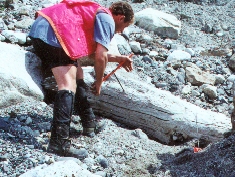 |
Dave collecting a core sample from a subfossil log. The increment borer cuts a pencil-thick core from the bark to the pith of the tree. Back in the lab this core is used to measure the tree-ring-widths and then to provide a tree-ring cross-date of the tree. Two to six cores were collected from each subfossil log used in this study. |